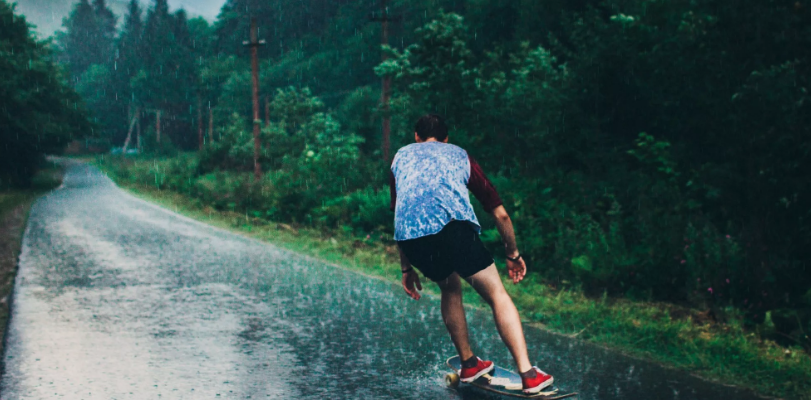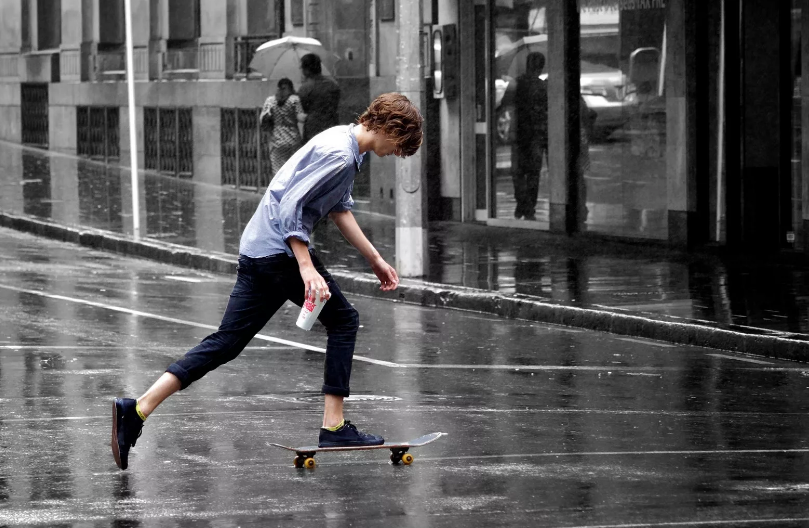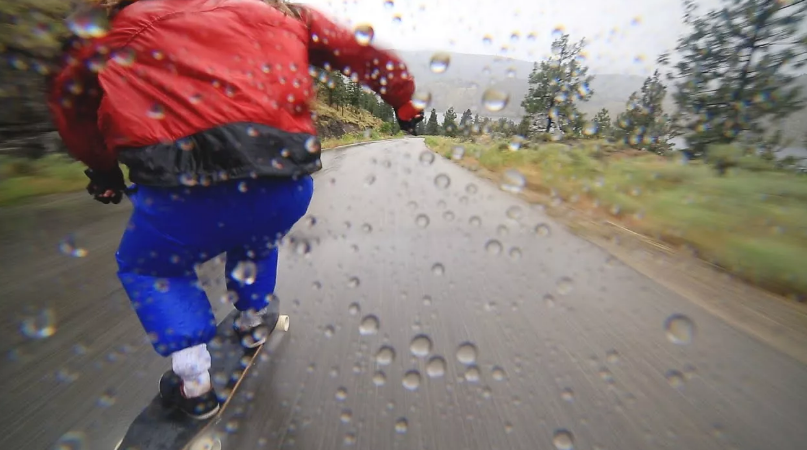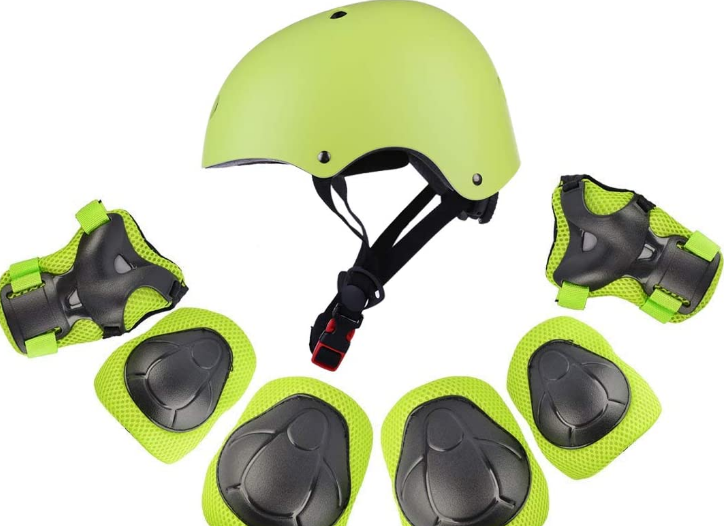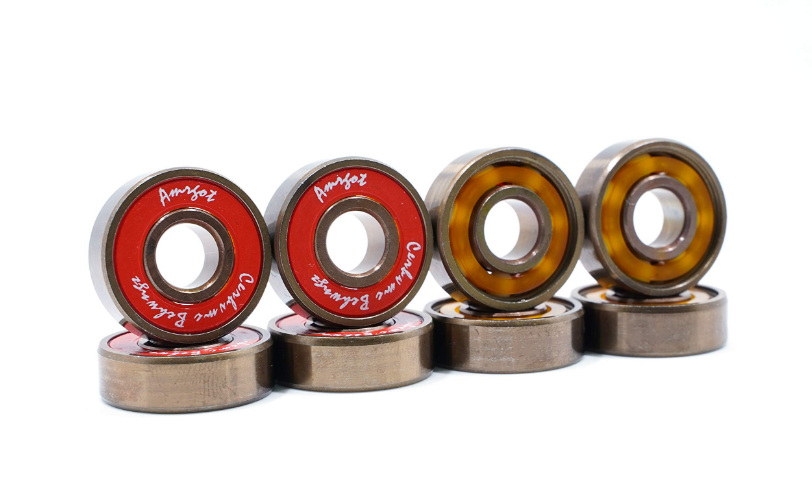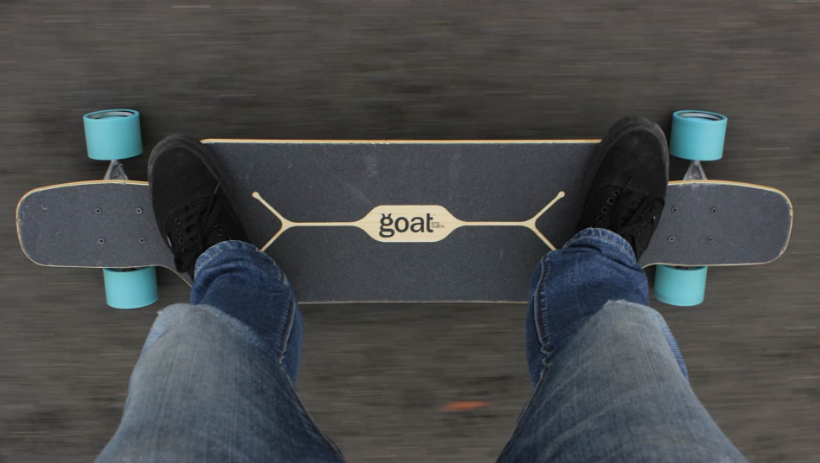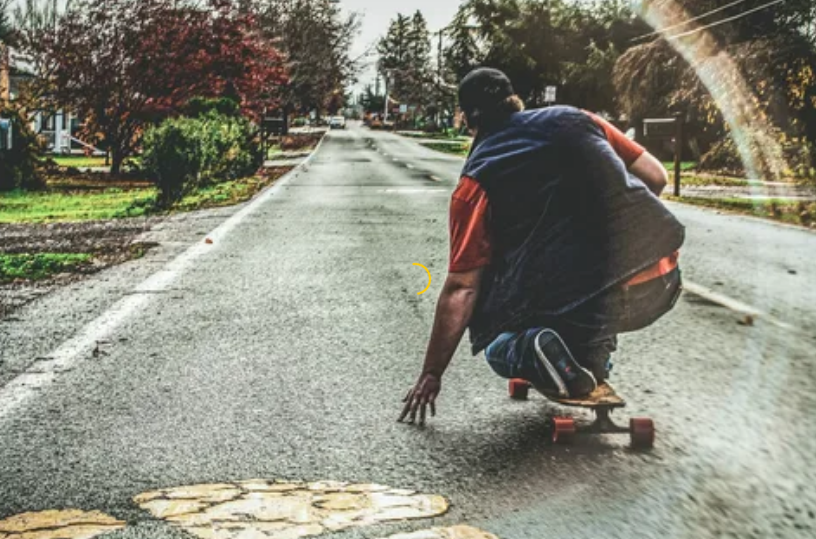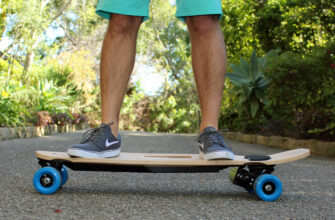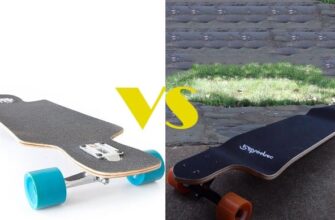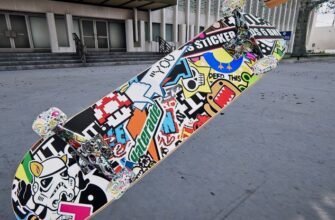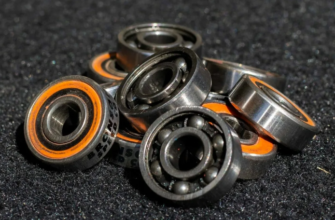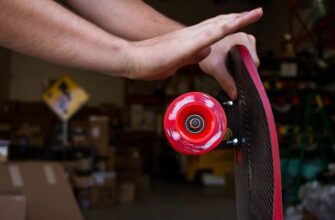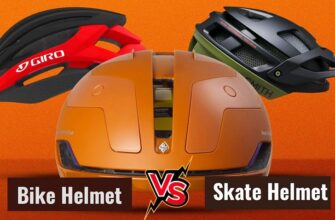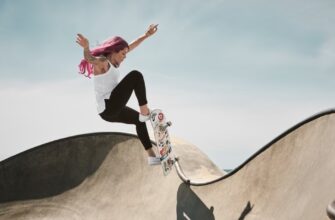You can longboard in the rain! Now, before you go and try it yourself, it’s important to understand a few things. First of all, longboarding on a rainy day can be both exciting and a bit riskier – but it can also bring some serious risks, like tripping over a missing cobblestone stone.
Puddles – no go! So, it’s important to know what to do to stay safe while you’re out there, including wearing safety gear.
In this article, we’ll give you some guidelines for longboarding in the rain. We’ll also tell you about the benefits and consequences of longboarding in wet weather, so you can make an informed decision about whether or not to do it.
- Is it possible to longboard in the rain on a wet surface?
- Risks involved
- Get the right helmet and safety pads
- Waterproof longboard
- Check your ceramic bearings
- Check your bearings regularly
- Not all bearings are waterproof
- Gear and equipment you need when riding longboards on a wet surface
- Protective gear
- Get the right grip tape
- Grip tape replacement
- Safety precautions to take when riding longboards in wet weather
- Wet roads
- Potential dangers of longboarding in wet conditions
- Riding in the rain consequences
- Tips for getting the most out of riding in wet weather
- Top mount
- Prolonging the life of your longboard bearings
- Advantages and disadvantages of longboarding in rainy weather
- What is warping?
- Conclusion
- FAQs
- Is it safe to longboard in the rain?
- Can you ride a longboard on wet pavement?
Is it possible to longboard in the rain on a wet surface?
Yes, it is possible to longboard in the rain. In fact, in some ways, longboarding in the rain can be more fun than longboarding on dry surfaces. The rain makes the pavement slick and wet, which can make for an exciting ride but be careful as you can lose traction very easily, avoid losing control by paying attention to every detail like painted lines.
Risks involved
However, there are also some risks associated with longboarding in the rain. The most important thing to remember is that wet pavement is much more slippery than dry pavement.
So, you need to take extra caution when riding in the rain. Make sure you wear a helmet and safety pads and don’t forget to wear slipper-resistant shoes, and slow down when you’re riding on a wet surface.
Get the right helmet and safety pads
Make sure you have the right gear to protect yourself from the rain. A longboard is a fun way to get around, but it can also be dangerous if you’re not prepared for the wet weather. Make sure you have a good raincoat, hat, and boots to keep yourself dry and safe.
Waterproof longboard
There are some manufacturers like Moonshine which produce a skateboard either with a rust-resistant metal or a waterproof longboard deck made of other material. You can use one of these for the rainy season if you’re not short on the budget.
Check your ceramic bearings
Bearings are an essential part of your longboard, especially on a rainy day. They help you move and make the board go. However, you have to apply some speed cream to them. That’s why it’s important to make sure they’re always in good condition.
Check your bearings regularly
One thing that you should do is check your ceramic bearings regularly to see if they’re rusting, but they are mostly rustproof. If they are, you can clean them with a cloth and some solvent. Be very careful when doing this, as bearings are delicate pieces of equipment. There are hybrid ceramic ones that are cheaper and only rust-resistant.
Not all bearings are waterproof
Another thing to keep in mind is that not all bearings made of ceramic are water-resistant. If you take your longboard out in the rain, the bearings will get wet and could potentially rust. To prevent this, you can coat them with a waterproof sealant but first, dry them out with a hairdryer blowing warm air.
Gear and equipment you need when riding longboards on a wet surface
You don’t need special gear or equipment when longboarding in the rain, but certain items can help improve your riding experience. For example, a waterproof jacket is essential if you want to stay dry and comfortable. Wearing gloves with padding can also help keep your hands from getting too wet and cold.
Protective gear
It’s also important to wear protective eyewear and footwear, as this will help protect you from debris and water splashing in your face or onto your feet. Finally, make sure that your longboard has good quality trucks, wheels, and bearings so that it doesn’t slip out from under you when the road is wet.
Get the right grip tape
One of the most important things to keep in mind when longboarding in wet weather is getting the right grip tape. This is the surface of your board that gives you traction and prevents you from sliding off.
During a thunderstorm, the roads can be quite slippery, so it’s important to make sure your grip tape is thick enough and has enough texture to provide a good grip even in wet conditions.
Grip tape replacement
If your grip tape has started to wear off, replace it before going out in wet conditions. You should also make sure the area around the edges of your deck is clean so that your feet have secure contact with the board when riding.
Safety precautions to take when riding longboards in wet weather
Before you hit the longboard in wet weather, there are some precautions you should take. Firstly, it is important to wear protective gear such as a helmet, elbow pads, knee pads, and shoes with non-slip soles.
You should also check that your board is dry before riding, as wet pavements can cause it to slip or slide. Additionally, you should ride at reduced speeds and avoid surfaces with puddles or water stains.
Wet roads
Wet roads can be slippery and dangerous due to their unpredictable nature; so try to stick to well-lit areas when riding in the rain. Lastly, always keep an eye on the sky for signs of thunderstorms and lightning, as these can be hazardous for all riders.
Keep your safety at the forefront of your mind when longboarding in wet weather – it could save your life!
Potential dangers of longboarding in wet conditions
Longboarding in wet weather can be an exciting way to experience the outdoors, but it can also bring some risks and thrills.
Since you are likely going to be gliding on wet pavements, there are some potential dangers that you should know about before embarking on your journey.
Riding in the rain consequences
For one, the ground will be much more slippery and harder to grip with your longboard. Also, wet surfaces can cause greater wear and tear on your board than in dry weather conditions, which can decrease your performance and lead to more accidents or injuries.
Additionally, the rain may affect your visibility of obstacles that come up quickly. Be sure to wear a helmet and other protective gear at all times when longboarding in wet conditions!
Tips for getting the most out of riding in wet weather
It’s important to take all necessary precautions when riding in wet weather, including wearing protective gear, such as a helmet and knee and elbow pads.
Top mount
When selecting a skateboard for rainy weather, always choose one with a top mount; else, you may wind up getting drenched in the rain.
You should also wear bright colors so that drivers can see you better in the rain. Symmetrical longboards are also better in wet weather than directional ones because they are more stable, and they don’t tend to slip out from under you.
In addition, you need to make sure that your longboard is well-maintained – check for any damaged or worn parts and make sure that your bearings are well-oiled, so they don’t get rusty.
It is also a good idea to lube down your trucks with a silicone-based lubricant, which will help reduce friction, which can be worse on slippery surfaces. Lastly, don’t forget to check the weather forecast before going out and avoid days with thunderstorms or heavy winds.
Prolonging the life of your longboard bearings
When longboarding in the rain, you should give special attention to your bearings as well. Normal bearings can get easily damaged if exposed to moisture or cleaning agents, so if you’re looking for an extra layer of protection, we suggest upgrading to ceramic bearings which are water-resistant.
If you decide to use your cheaper bearings for wet weather riding, make sure you dry them out and lubricate them after each ride. You can also help protect your board by making sure it doesn’t have any scratches or gouges that could allow water through and damage the wood.
If it does have scratches, make sure to seal your scratched deck using a waterproof coating, shoe water-repellent, floor sealer, or hair spray so that water won’t be able to get inside and cause damage.
Another tip? Consider getting rain wheels! They are made from a special type of urethane and other water-resistant materials that have a better grip on the water and will help give you better control when riding on a rainy day.
Finally, make sure that you wear shoes with proper grip—especially if it’s slippery out there! Slipper-resistant shoes will help keep your feet firmly planted on the board and help keep you safe while riding in wet weather.
Advantages and disadvantages of longboarding in rainy weather
Longboarding in the rain can certainly provide an adrenaline-filled experience, but there are a few things to consider before heading out for a ride. On the plus side, you get a chance to train your skills in less ideal conditions and the thrill of tackling difficult terrain.
Plus, the moist pavement will make it easier on your wheels to keep your speed. But on the downside, you risk getting soaked and possibly even experiencing a wipeout due to wet, slippery surfaces.
As with any activity, you’ll want to assess the risk and make sure that it’s safe to do what you want to do before heading out (for example, it may be unwise to ride in thunderstorms).
To stay safe while longboarding in rainy weather, consider investing in waterproof gear and wearing protective gear such as helmets and elbow pads.
What is warping?
Warping is the process of the wood absorbing moisture and expanding. Warping is a common issue in longboards while riding or boarding in wet weather because water can seep into the wheel wells, trucks, and fiberglass deck.
When it gets wet, it could expand or contract at different rates, and this could cause you to lose control to a certain extent. To avoid having a warped deck, you should always make sure your board is clean and dry before use.
You should also make sure to wipe down your board with a clean cloth after each ride and make sure it is completely dry before storing it away. It might be tempting to ride in the rain, but doing so could cause substantial damage to your longboard, so it’s best just to avoid doing so whenever possible!
Longboards that have been painted or coated are more resistant to water absorption in wet conditions. The deck should be covered with a thick layer from both the top and bottom sides to prevent it from being harmed by the downpour.
Conclusion
When it comes to longboarding in the rain, it’s important to remember a few things. First of all, make sure you have the right equipment. Board is in good condition, with grip tape, ceramic bearings, and safety pads.
Remember that wet surfaces can be dangerous, so take it easy and be aware of your surroundings. Board in controlled areas, and be aware of potential risks. Most importantly, have fun and enjoy the experience!
FAQs
Is it safe to longboard in the rain?
Riding a skateboard in the rain is a bit riskier than skateboarding on a sunny day. But it can be a lot of fun if you follow the tips on safety skateboarding in the rain mentioned above.
Can you ride a longboard on wet pavement?
Skateboarding in the rain is a little bit dangerous. Bearings deteriorate from the inside, grip tape peels off and loses grip, and the deck becomes soggy or delaminates. But there are waterproof and rustproof skateboard models nowadays.Wonder how to clean bearings longboard, read

